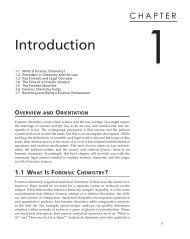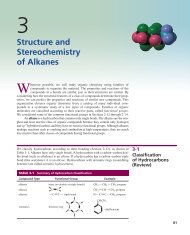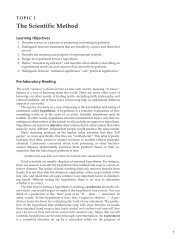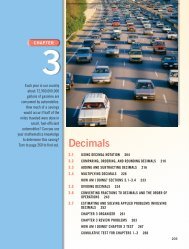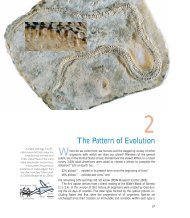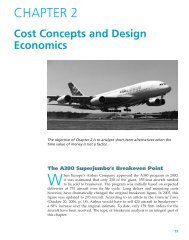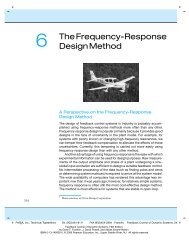CHAPTER 3 - Educators
CHAPTER 3 - Educators
CHAPTER 3 - Educators
Create successful ePaper yourself
Turn your PDF publications into a flip-book with our unique Google optimized e-Paper software.
98 <strong>CHAPTER</strong> 3/COST-ESTIMATION TECHNIQUES<br />
In general, all other things being equal, the CER with better goodness of fit measures<br />
should be selected.<br />
EXAMPLE 3-9 Regression Statistics for the Spacecraft CER<br />
Determine the SE and the correlation coefficient for the CER developed in<br />
Example 3-8.<br />
Solution<br />
From the spreadsheet for Example 3-8 (Figure 3-7), we find that the SE is 41.35<br />
(cell B15) and that the correlation coefficient is 0.985 (cell B12). The value of<br />
the correlation coefficient is close to one, indicating a strong positive linear<br />
relationship between the cost of the spacecraft and the spacecraft’s weight.<br />
In summary, CERs are useful for a number of reasons. First, given the required<br />
input data, they are quick and easy to use. Second, a CER usually requires very<br />
little detailed information, making it possible to use the CER early in the design<br />
process. Finally, a CER is an excellent predictor of cost if correctly developed from<br />
good historical data.<br />
3.5 Cost Estimation in the Design Process<br />
Today’s companies are faced with the challenge of providing quality goods and<br />
services at competitive prices. The price of their product is based on the overall<br />
cost of making the item plus a built-in profit. To ensure that products can be sold<br />
at competitive prices, cost must be a major factor in the design of the product.<br />
In this section, we will discuss both a bottom-up approach and a top-down<br />
approach to determining product costs and selling price. Used together with the<br />
concepts of target costing, design-to-cost, and value engineering, these techniques<br />
can assist engineers in the design of cost-effective systems and competitively priced<br />
products.<br />
3.5.1 The Elements of Product Cost and “Bottom-Up”<br />
Estimating<br />
As discussed in Chapter 2, product costs are classified as direct or indirect. Direct<br />
costs are easily assignable to a specific product, while indirect costs are not easily<br />
allocated to a certain product. For instance, direct labor would be the wages of a<br />
machine operator; indirect labor would be supervision.<br />
Manufacturing costs have a distinct relationship to production volume in<br />
that they may be fixed, variable, or step-variable. Generally, administrative costs<br />
are fixed, regardless of volume; material costs vary directly with volume; and<br />
equipment cost is a step function of production level.<br />
The primary costs within the manufacturing expense category include<br />
engineering and design, development costs, tooling, manufacturing labor,



